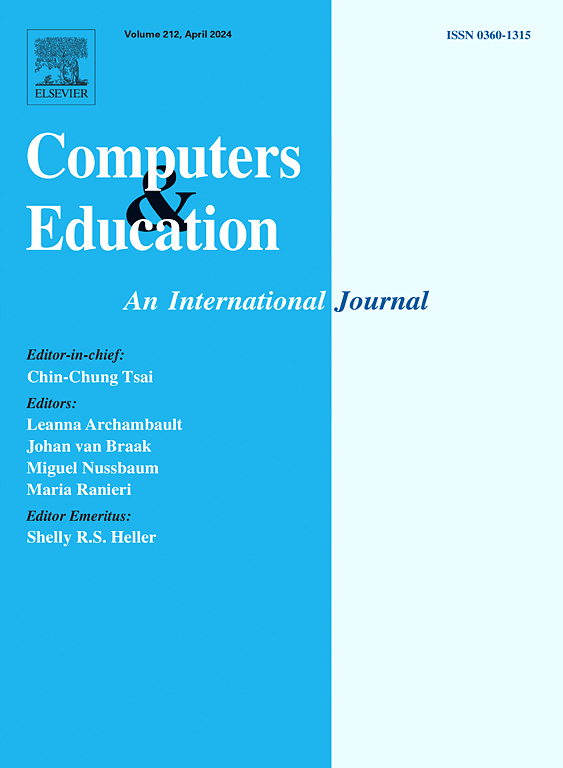Exploring learning effectiveness of integrating mixed reality in educational settings: A systematic review and meta-analysis
IF 10.5
1区 教育学
Q1 COMPUTER SCIENCE, INTERDISCIPLINARY APPLICATIONS
引用次数: 0
Abstract
This study employed a systematic review and meta-analysis approach to retrospectively analyze the literature related to the application of mixed reality (MR) technology in education from 2009 to 2025. The goal of this study was to ascertain the developmental trends, advantages, and challenges of applying MR technology in current educational practice. It scrutinized the current status of MR technology in relation to education, explored factors influencing the learning effectiveness of students, and calculated the effect size of the impact of MR on learning effectiveness within educational settings. The criteria for inclusion and exclusion were established prior to the analysis, culminating in a comprehensive study and discussion of 124 selected papers. The selected literature was then systematically analyzed. To further clarify the key variables affecting the efficacy of MR in educational applications, thirty-two papers with complete and eligible experimental data were entered for the final meta-analysis. The results showed that the overall average weighted effect size was 0.56 using a random-effects model, achieving a medium effect size standard. This encompassed 72 comparisons and involved 2251 students, with a 95 % confidence interval ranging from 0.28 to 0.85. This result indicates that educational contexts using MR technology were associated with higher learning outcomes compared to those using traditional teaching methods. Furthermore, an analysis of the moderating variables within the study revealed that the integration of MR technology in education is affected by three distinct variables: course learning duration, frequency of MR equipment usage, and presence or absence of teacher assistance during the research process. These variables exhibited significant differences that influenced the learning effectiveness. The study concludes with specific recommendations for the development of MR technology in educational contexts, in hopes that the findings will contribute valuable insights to the field.
探索在教育环境中整合混合现实的学习效果:系统回顾与元分析
本研究采用系统回顾和荟萃分析的方法,对2009年至2025年混合现实(MR)技术在教育中应用的相关文献进行回顾性分析。本研究旨在探讨磁共振成像技术在当前教育实践中的发展趋势、优势和挑战。本研究考察了磁共振技术与教育相关的现状,探讨了影响学生学习有效性的因素,并计算了磁共振技术对教育环境下学习有效性影响的效应量。在分析之前确定了纳入和排除标准,最终对124篇选定的论文进行了全面研究和讨论。然后对所选文献进行系统分析。为了进一步明确影响MR在教育应用中有效性的关键变量,我们输入了32篇具有完整和合格实验数据的论文进行最终的荟萃分析。结果表明,采用随机效应模型,总体平均加权效应量g+为0.56,达到中等效应量标准。这包括72个比较,涉及2251名学生,95%的置信区间从0.28到0.85。这一结果表明,与使用传统教学方法的教育环境相比,使用磁共振成像技术的教育环境与更高的学习成果相关。此外,研究中对调节变量的分析显示,核磁共振技术在教育中的整合受到三个不同变量的影响:课程学习时间、核磁共振设备使用频率以及研究过程中教师协助的存在与否。这些变量对学习效果的影响存在显著差异。该研究最后对磁共振成像技术在教育领域的发展提出了具体建议,希望这些发现能为该领域提供有价值的见解。
本文章由计算机程序翻译,如有差异,请以英文原文为准。
求助全文
约1分钟内获得全文
求助全文
来源期刊

Computers & Education
工程技术-计算机:跨学科应用
CiteScore
27.10
自引率
5.80%
发文量
204
审稿时长
42 days
期刊介绍:
Computers & Education seeks to advance understanding of how digital technology can improve education by publishing high-quality research that expands both theory and practice. The journal welcomes research papers exploring the pedagogical applications of digital technology, with a focus broad enough to appeal to the wider education community.
 求助内容:
求助内容: 应助结果提醒方式:
应助结果提醒方式:


